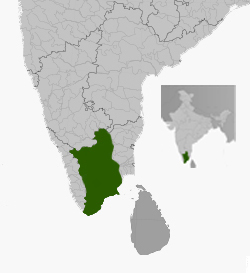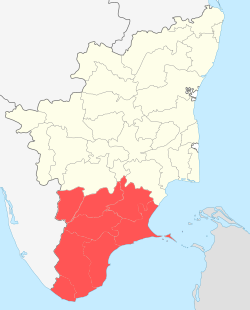
The Tamil people, also known as Tamilar, or simply Tamils, are a Dravidian ethno-linguistic group who trace their ancestry mainly to India’s southern state of Tamil Nadu, union territory of Puducherry and to Sri Lanka. Tamils who speak the Tamil Language and are born in Tamil clans are considered Tamilians. Tamils constitute 5.9% of the population in India, 15% in Sri Lanka, 7% in Malaysia, 6% in Mauritius, and 5% in Singapore.

The Carnatic region is the peninsular South Indian region between the Eastern Ghats and the Bay of Bengal, in the erstwhile Madras Presidency and in the modern Indian states of Tamil Nadu and southern Andhra Pradesh. During the British era, demarcation was different, including Karnataka and the whole region south of Deccan with black soil.

The history of southern India covers a span of over four thousand years during which the region saw the rise and fall of a number of dynasties and empires.

The Pandyan dynasty, also referred to as the Pandyas of Madurai, was an ancient Tamil dynasty of South India, and among the three great kingdoms of Tamilakam, the other two being the Cholas and the Cheras. Existing since at least the 4th to 3rd centuries BCE, the dynasty passed through two periods of imperial dominance, the 6th to 10th centuries CE, and under the 'Later Pandyas'. The Pandyas ruled extensive territories, at times including regions of present-day South India and northern Sri Lanka through vassal states subject to Madurai.

Tamiḻakam refers to the geographical region inhabited by the ancient Tamil people, covering the southernmost region of the Indian subcontinent. Tamilakam covered today's Tamil Nadu, Kerala, Puducherry, Lakshadweep and southern parts of Andhra Pradesh and Karnataka. Traditional accounts and the Tolkāppiyam referred to these territories as a single cultural area, where Tamil was the natural language and permeated the culture of all its inhabitants. The ancient Tamil country was divided into kingdoms. The best known among them were the Cheras, Cholas, Pandyans and Pallavas. During the Sangam period, Tamil culture began to spread outside Tamilakam. Ancient Tamil settlements were also established in Sri Lanka and the Maldives (Giravarus).

Rajendra Chola III was a brother and rival of Rajaraja Chola III, and came to the Chola throne in 1246 CE. Rajendra began to take effective control over the administration, and epigraphs of Rajendra Chola III indicate there was civil war ending with the death of Rajaraja Chola III. Rajendra's inscriptions laud him as the "cunning hero, who killed Rajaraja after making him wear the double crown for three years".

The region of Tamil Nadu in the southeast of modern India, shows evidence of having had continuous human habitation from 15,000 BCE to 10,000 BCE. Throughout its history, spanning the early Upper Paleolithic age to modern times, this region has coexisted with various external cultures.
Sholavandan is a panchayat town in Madurai district in the Indian state of Tamil Nadu. It is located on the left bank of the Vaigai River, sixteen miles north west of Madurai. It is one of 12 "town- panchayats" of Madurai district.

The Madurai Nayaks were rulers of Telugu origin from around 1529 until 1736, of a region comprising most of modern-day Tamil Nadu, India, with Madurai as their capital. The Nayak reign was an era noted for its achievement in arts, cultural and administrative reforms, revitalization of temples previously ransacked by the Delhi Sultans, and the inauguration of a unique architectural style.

The Early Pandyas of the Sangam period were one of the three main kingdoms of the ancient Tamil country, the other two being the Cholas, and Cheras Dynasty. As with many other kingdoms around this period, most of the information about the Early Pandyas come to modern historians mainly through literary sources and some epigraphic, archaeological and numismatic evidence. The capital of the Early Pandyan kingdom was initially Korkai, Thoothukudi and was later moved to Koodal during the reign of Nedunjeliyan I. The kingdom lay to the south of the Maurya Empire of India.

There are literary, archaeological, epigraphic and numismatic sources of ancient Tamil history. The foremost among these sources is the Sangam literature, generally dated to 5th century BCE to 3rd century CE. The poems in Sangam literature contain vivid descriptions of the different aspects of life and society in Tamilakam during this age; scholars agree that, for the most part, these are reliable accounts. Greek and Roman literature, around the dawn of the Christian era, give details of the maritime trade between Tamilakam and the Roman empire, including the names and locations of many ports on both coasts of the Tamil country. There are evidences as could be seen comparing standard forms of Sumerian literature and those recovered through present form of Tamil, for example the word for father in Sumerian transliteration is given as, "a-ia" that could easily be compared with Tamil word, "ayya". This also places ancient form of Tamil to early Sumerian period, say as ancient as 3500 BC.
Ariyanatha Mudaliar was the Delavoy (General) and the Chief Minister of the greatest of the Nayaka domains established by the Vijayanagar viceroy and later ruler of Madurai, Viswanatha Nayak (1529–64). He assisted in running a quasi-feudal organisation of regions called the poligar or the palayakkarar system where the regions are divided into palayams and are independently governed by poligars or palayakkarars.
Madurai District was one of the districts of the Madras Presidency of British India. It covered the present-day districts of Madurai, Dindigul, Theni, Ramanathapuram, Sivagangai and parts of Virudhunagar District in the Indian state of Tamil Nadu.

Tiruchirappalli is believed to be of great antiquity and has been ruled by the Early Cholas, Mutharaiyars Early Pandyas, Pallavas, Medieval Cholas, Later Cholas, Later Pandyas, Delhi Sultanate, Ma'bar Sultanate, Vijayanagar Empire, Nayak Dynasty, the Carnatic state and the British at different times. The archaeologically important town of Uraiyur which served as the capital of the Early Cholas is a Neighborhood of Tiruchirapalli.
Madurai is a major city in the Indian state of Tamil Nadu It is the administrative headquarters of Madurai District and a popular Hindu pilgrimage centre.

The Three Crowned rulers, or the Three Glorified by Heaven, or World of the Three or The Tamil Kings, primarily known as Muvendar, refers to the triumvirate of Chera, Chola and Pandya who dominated the politics of the ancient Tamil country, Tamilakam, from their three Nadu (countries) of Chola Nadu, Pandya Nadu and Chera Nadu in southern India. They signalled a time of integration and political identity for the Tamil people. They frequently waged war against one another under a period of instability and between each other, held control over Greater Tamilakam from 6th century BCE to the 13th century.

Kasi Viswanathar Temple in Tenkasi, a city in Tenkasi district in the South Indian state of Tamil Nadu, is dedicated to the Hindu god Shiva. Constructed in the Tamil style of architecture, the temple is believed to have been built by Pandyan ruler Parakrama Pandyan during the 13th century, with later additions from Madurai Nayaks. Shiva is worshipped as Kasi Viswanathar and his consort Parvathi as Ulagamman.

Tenkasi Pandyas were the Pandya kings from Sadaavarman Parakrama Pandya to his successors who ruled with Tenkasi as their capital. With the invasion of the Sultanates, Vijayanagaras, and Nayakars from the fourteenth century onwards, the Pandyas lost their traditional capital of Madurai and shifted to cities like Tenkasi and Tirunelveli. Tenkasi was the last capital of the Pandyas. All the Pandyas from Sadaavarman Parakrama Pandya and his next generations were crowned in the Adheenam Mutt in Kasi Viswanathar temple. During the same period, some Pandyas ruled with Tirunelveli as their capital. Kayatharu, Vadakkuvalliyur, and Ukkirankottai are some of their major cities. Inscriptions on them are found in Tenkasi's Kasi Viswanathar temple, Brahmadesam, Cheranmadevi, Ambasamudram, Kalakkad and Pudukkottai. The last Pandyan king to be known in the history of the Pandyas was Kolakonda, who was also among the Tenkasi Pandyas.

Tamil dynasties are the kingdoms who ruled over present day Tamil Nadu, Sri Lanka, Andhra Pradesh, Karnataka, Kerala and Odisha. These include the Pallavas, the Pandyas, the Cholas and the Cheras.














